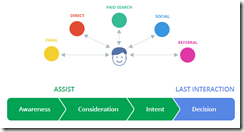The five forces of the Consumerization of Information Technology (CoIT) do not just affect the chief information officer (CIO). The impact of social media, Big Data, analytics, mobility, cloud computing and unified communications will be felt across every business unit and across every enterprise.
However, it is the office of the CMO – the organizational executive responsible for the “front of house” – which will be increasingly exposed to the challenges presented by consumerization. As a result, marketing leaders will face significant new strategic and technology decisions in the next two years.
Outdated theories and metrics, however, frame the practice of business marketing and continue to inhibit the ability of marketers to respond to the rapidly changing consumerized landscape. CMOs need to plan and execute against a new vision of the connected consumer.
The connected consumer, who uses a range of digital and social networking technologies, discovers, debates and decides on purchases in a completely new way. These processes occur almost completely independent of your brand, your communications and the messages they carry. The connected consumer may share your Facebook fan page with friends and buy your products on the way home. She or he may be your greatest critic or your staunchest defender. They blog, tweet, write reviews, self-publish books and hold online film festivals. They are influencers in their own right.
Marketers need to adopt a long-term view that demotes the campaign-based thinking that has dominated the marketing agenda for decades, replacing it with a focus on relationships, value and customer experience.
Companies that are prepared for the future do three things right when it comes to digital marketing. First, they understand the customer journey as a series of flows between touch points over time – and plan and execute their marketing plans accordingly. Second, they understand the power of data and analytics to create a deeper understanding of that customer and the approaches that can deliver customer engagement at scale. And finally, CMOs are recasting the marketing funnel to model and map the customer journey to better direct their marketing investments.
My report into re-casting the marketing funnel for consumer engagement set out the new touchpoints that marketers need to map against their buyers journey. But this, of course, requires an understanding of that journey not from the brand point of view – which is inside-out – but from the outside-in. And this requires additional thought, planning and preparation. In fact, it needs education.
One of the great successes of Google has been it’s relentless focus on technology. This has also been one of its great failings – and lies at the heart of its lack of success with social networking. With search – where Google clearly dominates, they have followed the ICE approach:
- Interest – create interest and intrigue in the solution by generating immediate VALUE
- Contextualise – help EDUCATE the audience in this new world by contextualising the old vs new with patterns of user behaviour
- Evangelise – show, support and evangelise the OUTCOMES of the new behaviour in the new context
Not only have new behaviours emerged thanks to Google search – whole industries have been built, careers have flourished and our personal and professional lives have been shaped in new ways. Except in small pockets, this has not happened with other Google solutions.
But things are slowly changing.
 The Think with Google website has become one of my favourites over the last year or so. Their recent work on the How to Go Mo website took a huge step in educating and empowering marketers in their quest to understand mobile marketing. And now, this planning tool on the customer journey helps explain some of the complexity around multi-channel / omni-channel marketing, analytics and attribution.
The Think with Google website has become one of my favourites over the last year or so. Their recent work on the How to Go Mo website took a huge step in educating and empowering marketers in their quest to understand mobile marketing. And now, this planning tool on the customer journey helps explain some of the complexity around multi-channel / omni-channel marketing, analytics and attribution.
If Google wants to see more marketers getting value out of their digital marketing investments (which is in everyone’s best interest), then more of this work will be required. Having great technology is only half of any answer (or maybe even less). Without the people, you don’t have a party. For that, you need ICE.

